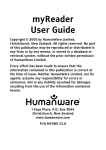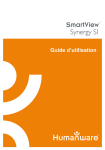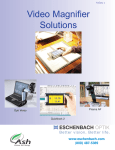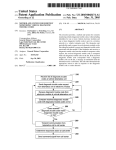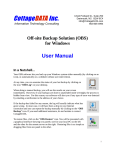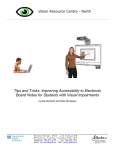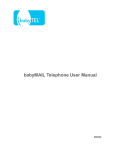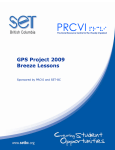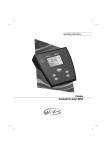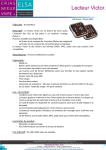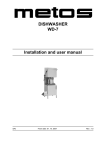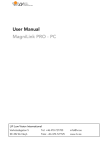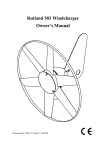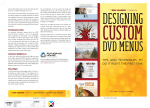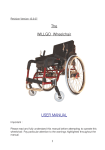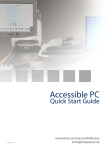Download LIVE (Menu)
Transcript
myReader2 User Guide Copyright © 2007 by HumanWare Limited, Christchurch, New Zealand. All rights reserved. No part of this publication may be reproduced or distributed in any form or by any means, or stored in a database or retrieval system, without the prior written permission of HumanWare Limited. Every effort has been made to ensure that the information contained in this publication is correct at the time of issue. Neither HumanWare Limited, nor its agents, assume any responsibility for errors or omissions. Nor is any liability assumed for damages resulting from the use of the information contained herein. 11 Mary Muller Drive, P.O. Box 3044 Christchurch, New Zealand www.humanware.com P/N MY254 V1.0 - 2 Patents Pending Important Safety Instructions 1. Follow all warnings, cautions, and instructions marked on the product. 2. The power supply cord is a disconnect device for pluggable equipment. The socket-outlet should be installed near the equipment, and be easily accessible. 3. This product is equipped with a 3-wire grounding type plug as a safety feature. This plug has a third (grounding) pin and can only be plugged into a grounding-type power outlet. If necessary, contact an electrician to replace your power outlet with a grounding-type power outlet. 4. This product should be operated from the type of power indicated on the marking label. If you are not sure of the type of power available, consult your dealer or local power company. 5. Refer all servicing of this product to qualified service personnel. Do not attempt to service it yourself, as opening or removing covers may expose you to dangerous voltage points or other risks. Contents Introducing myReader2................................................... 1 What's in the Box?.....................................................2 What's New?..............................................................2 Unpacking your myReader ..............................................6 Setting up your myReader .........................................7 The Control Panel ..................................................... 11 Plugging In myReader.............................................. 13 Folding up myReader ............................................... 14 Handling myReader ................................................. 15 Switching on myReader ................................................ 16 Choosing Where to Store your Page .............................. 17 Capturing an Image.......................................................20 Image Capture Summary ......................................... 23 Lighting ................................................................... 23 Autofocus ................................................................ 23 Straightening a Page ...............................................24 Flattening Reading Material .................................... 25 Rotating an Image ...................................................26 Clearing Pages ......................................................... 27 Special Page Slots A to C .........................................28 Reading Pages .........................................................29 Column, Row and Word Views..................................30 Page View ................................................................ 35 Live Mode ................................................................ 37 Menus ...........................................................................39 Navigating the Menus..............................................39 Menu Options .......................................................... 41 Screen Colours ..............................................................50 Full Colour Setting ...................................................50 High Contrast Settings.............................................50 Adjusting Brightness and Contrast .......................... 51 Sounds.......................................................................... 52 Language Setting .......................................................... 53 Choosing a Text Layout .................................................54 Clearing Changes .......................................................... 55 Screensaver ..................................................................56 User Colour Settings .....................................................58 How to Set User Colours ..........................................58 Changing User Colour Combinations ........................58 Connecting to External Devices.....................................60 Connecting to a VGA Monitor ................................... 61 Using myReader with a PC .......................................62 Connecting myReader to an External Camera ..........65 myReader Carry Bag .....................................................66 Maintenance .................................................................67 Caring for myReader ................................................67 Caring for the Trackball ...........................................67 Changing Bulbs ........................................................69 Troubleshooting............................................................ 73 Version Information......................................................76 Returning for Service.................................................... 77 • Introducing myReader2 See diagram on facing page. A Screen B Head C Handle D Platter E Guideline F On/Off Switch 1 What's in the Box? This user guide myReader2 unit myReader2 control panel Quick Start Guide Power cable Two plastic sheets VGA video cable for connecting myReader to a PC. Footswitch for use when myReader is connected to a PC or an external camera. What's New? As a result of feedback from users, HumanWare has added a number of powerful features and made changes to myReader to make it easier to use. Multi-page storage myReader now has multi-page storage. 10 pages can be stored for later reading. A new navigation bar allows you to quickly move around the stored pages. See Choosing Where to Store your Page, on page 17. Reference page storage 3 pages can now be stored as reference pages so that you can return to them. See Special Page Slots A to C, on page 28. 2 Overview Overview has been added to the View options to allow you to navigate easily between stored pages. A navigation bar is displayed in Overview. See Choosing Where to Store your Page, on page 17. Improved Menus The size of the menus has been increased and the menus are now easier to navigate. The layout of the menu has been simplified. An Exit option has been added to the Main Menu and a Back option added to each submenu. These options allow you to move around the menu system quickly and easily. See Menus, on page 39. Easy to use Control Panel The control panel has been redesigned so that the LIVE button now says LIVE (Menu). The READ/VIEW button is now the VIEWS button. The START button is now the CAPTURE button. The CAPTURE and VIEWS buttons are visually linked to indicate the close relationship between the two buttons. See The Control Panel, on page 11. Position Indicator A magnifying glass has replaced the rectangle as a position indicator. This appears on the screen when you are in Overview and Page View. Clear Messages and Prompts The myReader messages and prompts have been enhanced and simplified. 3 User Guide The User Guide has been updated. Screen Saver A full colour screensaver has been added. See Screensaver, on page 56. Changed and Removed Features To make myReader easier to use, some rarely used features have been removed and others have been changed. The removed and changed features are as follows: The image markers have been removed. The Page View (Viewing Mode) auto-scroll feature has been removed. The Page View (Viewing Mode) margins feature has been removed. The Page View (Viewing Mode) Next feature has been removed. The Live Mode freeze image feature has been removed. Activating and cancelling the Live Mode manual focus feature now requires holding down the VIEWS (Read/View) button for 2 seconds rather than just pressing it. Capturing a new page can now only be done when in Overview. If CAPTURE is pressed when in any other view, the view is first changed to Overview. Pressing the LIVE button when already in Live Mode no longer exits Live Mode. 4 For existing users who upgrade their myReaders to the latest software, a menu option has been provided to restore some of the removed features. The option is called "Classic Controls". See Advanced Menu, on page 46. Selecting "Classic Controls" restores the following features: - The Page View (Viewing Mode) auto-scroll feature. - The Page View (Viewing Mode) margins feature. - The Page View (Viewing Mode) Next feature. - The Live Mode freeze image feature. 5 • Unpacking your myReader 1. First of all, decide where you are going to set up myReader. The space should be flat and steady so that the whole base is in contact with the level surface, and clear of any loose items. A table or desktop is ideal. Don't set it up on a folding table or other unsteady piece of furniture. 2. Uniform lighting is important to get the best performance out of myReader. Avoid locations where direct sunlight or shadows can fall on myReader’s platter. Don’t shine a desk lamp onto the platter. 3. Check that there is a wall socket near enough to plug myReader in. If not, you will need to get an extension cord ready as well. 4. Take myReader out of its box. 5. Now position myReader where you want to use it, with the handle facing the front. 6 Setting up your myReader Warning: keep your hands away from all moving parts while unfolding myReader. A Press the release button at the right hand side of the base hinge and hold it down. Raise the unit by the handle. Release the button and keep lifting until it locks with a click. 7 B Press, and hold in, the hinge release button at the top of the right-hand side of myReader. The button does not push in fully. Keep holding the button in while you push the front of the screen, gently at the bottom to release it. The button should now push in fully. C Pull the screen out, release the button and raise the unit until you hear it click. 8 D Unclip the screen by pushing the lever at the back of the top of the unit. 9 E Pull the screen forward and down until you are happy with its position. 10 The Control Panel Size Live Picture (Menu) Capture Views Next/Stop 11 Speed 12 Plugging In myReader See diagram on facing page. A Connect the control panel to the connector labeled "Control Panel" on the back of myReader’s base. Put the flat of the control panel’s connector to the bottom. You cannot operate myReader without its control panel. B Connect the power cable to the connector labeled “Input Power”on the back of myReader’s base . Put the flat of the power cable’s connector to the top. 13 Folding up myReader Warning: keep your hands away from all moving parts while folding up myReader. Fold up myReader in the reverse order of unfolding it: 1. Push the screen up and back until it is flat against the top of the unit, and the clip clicks into place. 2. With your left hand supporting the top front, push the top button to release the hinge, and gently lower the top until it clicks into place. 3. Holding the handle with your left hand, press the button to release the base hinge, and gently lower to the base until it clicks into place. For safety reasons, myReader switches its lights off when it is folded up. To turn on the lights again, switch myReader off then on using the On/Off button at the bottom of the screen. 14 Handling myReader Follow these basic rules to keep your unit in top working condition. Never place any objects on the top of myReader, whether it is set up or folded down, no matter how light they are. When folded, always rest myReader flat and with the base down. Do not leave it standing on its end. Keep it away from extremes of heat or cold, and water or liquids, including steam. Ensure that the cables and leads are not trapped underneath the unit and are not bent or pinned down except by proper cable fittings. Avoid touching the surface of the screen. If necessary, give it a dust with a soft cotton cloth from time to time. 15 • Switching on myReader Once myReader is plugged in, you can switch it on. Press the On/Off button. "Welcome to myReader2" is displayed on the screen. After a few seconds Overview is displayed. If pages have previously been captured, then the page that was on the screen when myReader was turned off is shown. When you see the message "Place page then press Capture", myReader is ready to start work. Note: If your myReader doesn’t have a built-in screen, you will find the On/Off button at the centre of the front of the head. See Setting up myReader with an External Screen, on page 60. 16 • Choosing Where to Store your Page Instead of simply magnifying the text of what you want to read, myReader captures an image or snapshot of the item on its platter. It then works with the image to make it easier for you to read. You can capture up 10 pages for later reading. You can also save 3 pages as reference pages. See Special Page Slots A to C, on page 28. Before you capture an image you can select the page slot that you want the captured image to be stored in. For example, if you want to read a 10 page document, start by selecting page slot 1, and capture page 1. Then select page slot 2, and capture page 2, and so on. After capturing all 10 pages, you can go back to page 1 then sit back and read all 10 pages in sequence. If you don't want to capture multiple pages, you can always stay in page slot one. 17 Note: Unless specified otherwise, captured pages are retained when myReader is switched off so that you can come back the next day and continue reading where you left off. See Clearing Pages, on page 27. There are a number of ways to move around the pages that you use to store captured images. You can: Use the trackball to move the magnifying glass over one of the page numbers displayed on The Navigation Bar at the bottom of the screen. 1 2 3 4 5 6 7 8 9 10 A B C Use the Trackball to move the magnifying glass over the left or right arrow to move to the previous or next page. 18 Press the NEXT/STOP button on the control panel to take you to the next page. Scroll the Speed dial down to go to the next page, or up to go to the previous page. 19 • Capturing an Image Because myReader captures the full page as a snapshot it is important that the page is held still and your fingers do not obscure the text. 1. Position the document so that it is pushed against the ridge at the back of the platter. Check that the document is within the white lines on the platter. Any part of the document that is outside the white lines will be cut off. 2. Select the page slot that you want the captured image to store in. If you are capturing the first of a number of images, you will probably select page slot 1. See Choosing Where to Store your Page, on page 17. 3. Press the CAPTURE button on the Control Panel. If you are not in Overview when you press Capture, myReader will switch to Overview and ask you to press CAPTURE again. Note: If you are reading something that won’t stay flat by itself, use the clear plastic sheet provided (this is the larger of the two plastic sheets). Place it over the page before pressing the CAPTURE button. See Flattening Reading Material, on page 25 for more information. 20 4. After a pause, the document is displayed. If necessary, adjust the size with the SIZE knob and the colour with the PICTURE knob. See Screen Colours, on page 50. 5. Rotate the image if necessary. See Rotating an Image, on page 26. 6. Use the Trackball to move the magnifying glass around the page to locate the text you wish to read. 21 Size Live Picture (Menu) Capture Views 22 Next/Stop Speed Image Capture Summary To capture an image: (see diagram on facing page) A Switch myReader on. B Place the item on the platter. C Use the Navigation bar to select the page slot that you want to use. D Press the CAPTURE button. After a short delay, it will be displayed and you can start reading. Lighting Like a camera, myReader is affected by ambient lighting. myReader works best when light sources are even and uniform. Make sure that there is no direct sunlight or shadow falling on myReader’s platter. Autofocus myReader has Autofocus, which means that it does all the focusing for you. 23 Straightening a Page You don't need to place the item perfectly straight on the platter. myReader automatically straightens the image of the document for you. As long as it is no more than about 10 degrees crooked, myReader will automatically correct this when it processes the text. Too Crooked? If a document is too crooked for myReader to straighten, there will be one long beep and the message: “Straighten page then press Capture again” will display on the screen. Simply straighten it a little and try again. 24 Flattening Reading Material With books the pages usually curve into the spine. To help flatten the book, use the clear plastic sheet provided (the larger of the two plastic sheets). Place it over the page before pressing the CAPTURE button. To avoid covering the text with your fingers, you can place the clear plastic sheet over one of the pages and hold the other half of the book at a slight angle. The plastic sheet is also useful for flattening magazines and newspapers, or single pages that have been folded or crumpled, or are curling up at the edges. When using the plastic sheet, be careful to avoid reflections from room lights. When an image is captured, reflections from the room lights will show up as a light or dark patch on the screen. Alternatively, reflections from the room lights might cause the whole image to be lighter or darker than normal. If this happens, turn off or dim the room lights. If necessary, move myReader to another position away from the lights. 25 Rotating an Image You don't need to put the item on the platter the right way up. myReader can rotate the page on screen. This is very useful for viewing items that fit best on the platter sideways, for example, pages printed in "Landscape" orientation, where the page is printed with the longest edge to the top. myReader rotates the image clockwise by 90 degrees at a time. To rotate an image: Press and hold down the CAPTURE button. Continue to hold the CAPTURE button for two seconds after capture and the image will rotate by 90 degrees. If you keep holding down CAPTURE, the image will keep rotating every two seconds. Note: Column, Row and Word Views only work when the text is the right way up. 26 Clearing Pages You may wish to immediately clear a captured document from the display when you are finished. To do this, clear the platter and press CAPTURE. Although capturing a new page automatically overwrites a previously stored page, for privacy reasons you might want to delete pages without using capture. To delete the current page: Press the LIVE (Menu) button for two seconds to open the Main Menu. Roll the SPEED dial down to highlight Delete and press LIVE (Menu). Roll the SPEED dial down to highlight Current Page and press LIVE (Menu). Roll the SPEED dial down to highlight Delete Page in the Confirm Menu. Press LIVE (Menu). To delete all pages: Press the LIVE (Menu) button for two seconds to open the Main Menu. Roll the SPEED dial down to highlight Delete and press LIVE (Menu). Roll the SPEED dial down to highlight All Pages and press LIVE (Menu). Roll the SPEED dial down to highlight Delete All in the Confirm Menu. Press LIVE (Menu). 27 You can also choose to delete all pages everytime you turn myReader off: Press the LIVE (Menu) button for two seconds to open the Main Menu. Roll the SPEED dial down to highlight Delete. Roll the SPEED dial down to highlight At Power Off and press LIVE (Menu). Note: The special page slots (reference pages) A, B and C are not affected by the Delete All and the Delete At Power Off commands. Special Page Slots A to C The special page slots are designed to be used to store reference pages, that you want to store longer than others. To save a document to page slot A, B or C: Select the letter from the Navigation bar by rolling the Trackball over it. Press the CAPTURE button. If you have a page already stored in this page slot, the message "Press Capture again to overwrite or NEXT to cancel" is displayed. 28 Reading Pages When you capture a page you are in Overview and the navigation bar is displayed. You can change the view by pressing the VIEWS button. The VIEWS button cycles you through the views. Try pressing it a few times to see how the views change. From Overview, when you press the Views button once you move to Page View. Page View displays the page that is stored in the current page slot. You can move around the page with the track ball. Page View is also useful for displaying pictures and pages with complicated layouts. See Page View, on page 35. Press the VIEWS button again to go to Column View. Press the VIEWS button again to move to Row View. These views are explained in Column, Row and Word Views, on page 30. 29 Column, Row and Word Views Column, Row and Word Views are good for reading documents with straightforward layouts like books, letters and some newspapers and magazines. Instead of simply magnifying the document, myReader rearranges the text on the screen. It changes the layout of the page and removes any pictures so that you can read more quickly and more comfortably. As all of the lines on the page follow on from each other, you don't have to waste effort searching for the start of the new line. You can change the default layout using the Menu. See Choosing a Text Layout, on page 54. Note: Some documents cannot be read in these views. These include documents with poor quality printing, with a lot of pictures, with complicated layouts or with text that wraps around the curves of pictures. If myReader detects that the page can’t be read in Column, Row or Word View, it will either display the message “Reading mode not available for this page” or display jumbled or missing text. Use Page View for these documents. See Page View, on page 35. 30 Reading a page To begin reading, follow these steps: Press the VIEWS button on the Control Panel until you are in Column View. Column View displays all the text on the page in a single column, wrapped to fit the screen. The text moves up the display as you read it. Column layout displays all the text 31 You can also choose to display the text in a row. To do this, press the VIEWS button again. Row View displays the text in a single, continuous row. This is good if you need a high magnification. Row layout di The best way to find out which layout is best, is to try them out and find the one that works for you. You can use the Menu to change the default layout to suit your requirements. You can also set the layout to display only one word at a time. See Choosing a Text Layout, on page 54. 32 In Column, Row or Word view, you can: Rotate the SIZE knob so that the text displays at a size suitable for your viewing. Change the colour of the text and background, by rotating the PICTURE knob. Move around the text using one of the following three options: Automatic Reading using the SPEED dial: Roll the SPEED dial down, and the text scrolls (moves across the screen) automatically. To make it go faster, roll the dial down again. To slow down, or stop, roll the dial up. You can also stop scrolling by pressing the NEXT/STOP button. Touching the Trackball momentarily overrides the automatic scrolling. When you take your hand off the Trackball, scrolling resumes. Manual Reading using the Trackball: Control the scrolling manually using the Trackball. Manual Reading using the NEXT/STOP button: Press the NEXT/STOP button to display the next screenful of text. This is useful if you find it uncomfortable to read moving text . Go back to Overview, by pressing the VIEWS button again. 33 Reading Next and Previous Pages The top and end of each page is indicated by the page number in a circle, between two filled circles. 5 You can see what page you are on by looking at the number at the top or end of the page. To go to the next page from the end of the current page when you are in Column, Row, or Word view, roll the Speed Dial down, or press the NEXT/STOP button To go to the previous page from the top of the current page when you are in Column, Row, or Word view, roll the Speed Dial up. Note: When you are in Column, Row and Word Views, you can't use the Speed Dial or the NEXT/STOP button to move between page slot 10 and Special Page slot A, or between Special Page slots A, B and C. To do this, press VIEWS to go back to Overview. 34 The Magnifying Glass Page View and Column, Row and Word View can be used as an effective combination for reading. In Page View, a location indicator displays as a magnifying glass in the foreground colour. The magnifying glass frames the part of the page that is currently being displayed in Column, Row or Word view. By moving the magnifying glass, you can select a new part of the page to read. If you use fairly low levels of magnification to read, and the magnifying glass gets in your way when reading, you can change the settings in the menu. See Preferences Menu, on page 45. You can turn the magnifying glass off in Page View, or set it so that it is on at the minimum magnification level, and goes off above 1.5x magnification. Page View To read pages with complicated layouts that don’t suit a Reading View, use Page View. Page View is also designed for viewing pictures, photos, diagrams, and documents with layouts that are important to their meaning, such as tables and spreadsheets. It displays the page in its original layout. You can also use Page View to select which part of the page to go to when you switch to Column, Row or Word View. See Magnifying Glass above. 35 Viewing Pictures Pictures are best viewed in Page View. To view a picture, capture it in the usual way and rotate the PICTURE knob to the full colour setting. With pictures in offset-printed material like magazines, brochures and fliers, you might notice a coloured pattern of crosshatching. This is called “moiré” and is due to the fact that these pictures are made up of a series of dots. You can get rid of the crosshatching by using the smaller of the two plastic sheets that are provided with myReader. This plastic sheet is labeled “Picture Hold Down Sheet. This Way Up.” Place the sheet over the page, the correct way up, and recapture the page. You will now be able to view the picture without the crosshatching. When using the plastic sheet, be careful to avoid reflections from room lights. When an image is captured, reflections from the room lights will show up as a light or dark patch on the screen. Alternatively, reflections from the room lights might cause the whole image to be lighter or darker than normal. If this happens, turn off or dim the room lights. If necessary, move myReader to another position away from the lights. 36 Live Mode When myReader is in Live Mode, it shows a live image of what is on, or above, the platter. This is very useful for reading labels on curved surfaces, such as bottles, and for writing cheques, and other manual activities. The viewing area in Live Mode is at the front of the platter. Switching to Live Mode To activate Live Mode, simply press the LIVE (Menu) button. To switch back to your previous display, press the VIEWS button. When you change to Live Mode an additional lamp will automatically switch on. This lamp is only needed in Live Mode and will automatically switch off when you exit Live Mode. A quick way to tell if you are in Live Mode, is by seeing whether the lamp is on or not. Functions Available in Live Mode In Live mode you can: Adjust the SIZE and PICTURE controls, and Press CAPTURE at any time and capture an image of what is on the platter for viewing or reading. 37 Manual Focus in Live Mode In Live Mode, you can change from Autofocus to Manual focus. Manual focus is useful for viewing three dimensional objects, and for activities such as writing where Autofocus might try to focus on your hand or on the pen rather than on the paper. To turn off Autofocus, press the VIEWS button for 2 seconds. Adjust the focus manually using the SPEED dial. The focus is reset to automatic when you press the VIEWS button for 2 seconds again or when you exit Live Mode. Viewing Pictures in Live Mode Pictures are best viewed in Page View but can also be viewed in Live Mode. With pictures in offset-printed material like magazines, brochures and fliers, you might see a coloured pattern of crosshatching on the screen. For instructions on how to get rid of crosshatching, see crosshatching, refer to page 36. 38 • Menus myReader has a simple menu system for handling settings and preferences. There are two types of menu items: Items that have another level of menu beyond them end with >. For example, Preferences >. Items that include the selections available such as Volume (Soft/Loud/Mute), or Brightness which has a sliding scale. The current selection is highlighted so you can see where you are in the menu. As you move around, the highlighting moves too, so it is always clear what you are selecting. Navigating the Menus Below is a list of menu commands and how to operate them. Open the Main menu. Press LIVE (Menu) for two seconds. Move up and down the menu items. Roll the Speed dial or Trackball up and down. Go to the next menu level (on a menu item that has a > directly after it). Press LIVE (Menu). 39 Cycle through available settings offered in a menu item. Press LIVE (Menu). Set a slider level in a menu item. Roll the Trackball to the right or left. Move back to the previous menu level. Select the Back option on the menu screen. Exit the menu system. Select the Exit option from the Main Menu screen, or do nothing for 2 minutes. Where there is a range of available settings for a menu item, the one that is showing when you exit will be saved. 40 Menu Options The tables below show the menu options. Main Menu Settings Menu Exit Display Menu Back > Display > Brightness Column/Ro w English UK Preferences > Contrast Advanced > User Colours > > Split Screen > Screensaver > Settings Layout Language Back Delete Preferences Menu Advanced Menu Back Split Screen Back Soft Back Version Info > Ratio 3 Factory Defaults > PC Display Mode Display On Classic Controls Off Magnifying Glass On Volume Trackball User Colours 50/50 1Min Lights Off Version Info Factory Defaults Back Back Foreground Serial # : 10645 Background Software: 1.05.06 Back Restore Now Default Delete Screensaver Back Confirm Back Current page n> > All Pages At Power Off Off Back Save Delete All 30 Min Time-Out Delete Confirm Back Delete page n 41 Top Main Menu Press the LIVE (Menu) button for 2 seconds to open the Main Menu. Main Menu Exit > Settings Layout Column/Row Language English UK > Delete Exit closes the Main Menu. Settings takes you to the Setting Menu. See Settings Menu, on page 43. Layout (Column/Row) controls the Views you use when you are in Reading view. Press LIVE (Menu) to cycle through the options. Language (English UK) sets the language for the screen messages and menu items. Press LIVE (Menu) to cycle through the options. Delete takes you to the DeleteMenu. See Delete Menu, on page 48. 42 Settings Menu To display this menu, select Main Menu>Settings Settings Menu Back Display > Preferences > Advanced > Split Screen > Back takes you back to the Main Menu. Display takes you to the Display menu, where you can change the properties of the display, for example the brightness and screen colours. See Display Menu. Preferences takes you to the menu where you can adjust the Volume and Trackball sensitivity. See Preferences Menu. Advanced takes you to the Advanced Menu. Split Screen takes you to the Split Screen menu. 43 Display Menu To display this menu, select Main Menu>Settings> Display Display Menu Back Brightness Contrast User Colours > Screensaver > Back takes you back to the Settings Menu. Brightness lets you change the brightness of the display. Use the Trackball to change the sliding scale. You can also use the Brightness buttons on the front of your screen. Contrast lets you change the contrast of the display. Use the Trackball to change the sliding scale. See Adjusting Brightness and Contrast, on page 51. User Colours takes you to the User Colours Menu. See User Colours Menu, on page 48. Screensaver takes you to the Screensaver Menu. See Screensaver, on page 49. 44 Preferences Menu To display this menu, select Main Menu>Settings> Preferences Preferences Menu Back Volume Soft 3 Trackball Mode Display On Magnifying Glass On Back takes you back to the Settings Menu. Volume is used to change the level of volume. Press the LIVE (Menu) key to scroll through the settings. Trackball is used to adjust the sensitivity of the Trackball. Press LIVE (Menu) to scroll through the scale, from 1 to 5, where 5 gives the highest sensitivity. Mode Display lets you turn off (and on) the message that appears at the top of the screen when you change display mode. Magnifying Glass lets you turn off (and on) the magnifying glass in Page View, or set it so that it is on at the minimum magnification level and goes off above 1.5x magnification. 45 Advanced Menu To display this menu, select Main Menu>Settings> Advanced. Advanced Menu Back Version Info > Factory Defaults > Classic Controls Off Back takes you back to the Settings Menu. Version Info lets you see the serial number and software version of your myReader. Factory Defaults lets you reset your myReader to the factory defaults. Classic Controls allows users who have upgraded from a previous version of myReader to restore features that are no longer available in myReader2. 46 Split Screen To display this menu, select Main Menu>Settings>Split Screen. Use this menu when you have a PC connected to myReader. See Connecting to External Devices, on page 60. Split Screen Back Ratio 50/50 PC Display Top Lights Off 1min Back takes you back to the Settings Menu. Ratio lets you set the ratio between the PC part of the display and the myReader camera part of the display. PC Display is used to specify which part of the display the PC picture is displayed on. The options are Top or Bottom (with a horizontal split) or Left and Right (with a vertical split). The default is Top. Lights Off sets the time delay between full screen PC display or external camera display being selected and myReader's lights going off. The default is 1 minute. "On" can be selected to disable this feature. 47 User Colours To display this menu, select Main Menu>Settings>Display>User Colours. User Colours Back Foreground Background Default Use this menu to change your display colours. See User Colour Settings, on page 58. Delete To get to this menu, select Main Menu>Delete. Delete Back Current page All pages At Power Off n> > Off Use this menu to delete captured pages. See Clearing Pages, on page 27. 48 Screensaver To get to this menu, select Main Menu>Settings> Display >Screensaver. Screensaver Back Save Time-Out 30 Min Delete Use this menu to change your Screensaver Settings. See Screensaver, on page 56. 49 • Screen Colours Because users have individual colour and contrast preferences, myReader offers a wide range of colour options. These include full colour, high contrast black and white, and user colours. These are controlled by turning the PICTURE knob. Full Colour Setting The full colour setting displays the colours as they are on the original page or item. It is useful for looking at colour pictures, and in Live Mode for doing manual operations. High Contrast Settings The high contrast settings are ideal for reading text, as the maximum contrast between the text and the background makes it easier to read. The PICTURE knob has seven high contrast settings black on white (positive), white on black (negative), and five high contrast user colour settings. To define your own colour settings. See User Colour Settings, on page 58. 50 Adjusting Brightness and Contrast Brightness and contrast can be adjusted in the Display Menu, off the Settings menu. They each have a sliding scale, adjusted by rolling the Trackball left or right. You can also use the Brightness buttons on the front of the monitor to make small changes to the brightness. 51 • Sounds myReader uses a range of different sounds to help you to know what is going on. You can change the volume of these sounds in the Main Menu. The factory setting is "Soft", but you can also choose from "Loud" or "Mute". 52 • Language Setting myReader has 13 language settings: English (U.K.) English (U.S.) Danish Dutch Finnish French German Italian Norwegian Portuguese Slovenian Spanish Swedish To change the language of the menus, screen messages, and prompts to any of these settings: 1. Press the LIVE (Menu) button for two seconds to open the Main Menu. 2. Roll the SPEED dial down to highlight the Language option. 3. Press LIVE (Menu) to cycle through the languages to the one you want. 4. Roll the SPEED dial up to highlight Exit and press LIVE (Menu). 53 • Choosing a Text Layout Column View and Row View are available by default when you press the VIEWS button. However, you can change this so that only one mode is available. This can be Column View, Row View or Word View. To change layouts, follow these steps: 1. 1. Press the LIVE (Menu) button for two seconds to open the Main Menu. 2. Roll the SPEED dial down to highlight the Layout option. 3. Press LIVE (Menu) to scroll through the Layout options. 4. When the layout option that you want to use is displayed, roll the SPEED dial up to highlight Exit. Press the LIVE (Menu). 54 • Clearing Changes If you have made changes to settings available in the menus and wish to change them back to the factory defaults, you can do so from the Factory Defaults menu option in the Advanced Menu: 1. Press the LIVE (Menu) button for two seconds to open the Main Menu. 2. Roll the SPEED dial down to highlight Settings and press LIVE (Menu). 3. Roll the SPEED dial down to highlight Advanced and press LIVE (Menu). 4. Roll the SPEED dial down to highlight Factory Defaults and press LIVE (Menu). 5. Roll the SPEED dial down to highlight Restore Now. 6. Press LIVE (Menu) to go back a menu. Select Back again until you are back at the Main Menu. 7. Highlight Exit in the Main Menu and press LIVE (Menu) to leave the menus. 55 • Screensaver If no control is operated for 30 minutes, a screensaver is displayed. The default screensaver is the HumanWare logo. You can store your own screensaver by saving what is currently on the display. 1. To save a screensaver, you must be in Page View, with Full Colour selected. See Full Colour Setting, on page 50. 2. Press LIVE (Menu) for 2 seconds to open the Main Menu. 3. Roll the SPEED dial down to highlight Settings and press LIVE (Menu). 4. Roll the SPEED dial down to highlight Display and press LIVE (Menu). 5. Roll the SPEED dial down to highlight Screensaver and press LIVE (Menu). 6. Roll the SPEED dial down to highlight Save to save the page that you currently have displayed. 7. Roll the SPEED dial up to highlight Back and press LIVE (Menu). Select Back again until you are back at the Main Menu. 8. Highlight Exit in the Main Menu and press LIVE (Menu) to leave the menus. 56 If you delete the Screensaver from the Screensaver menu, myReader returns to the default screensaver. Use the Time-Out option in the Screensaver Menu to select how long myReader is inactive before the Screensaver is displayed. 57 • User Colour Settings The user colour settings option allows you to select combinations of foreground and background colours instead of black and white. The colours available are black, white, red, magenta, yellow, cyan, green and blue. How to Set User Colours The five most popular user colour settings are available by turning the PICTURE knob. If you prefer other combinations, you can change any or all of them. Changing User Colour Combinations User colour combinations are changed in the menus. You can change one or both colours. The text is always the foreground colour. To change any of the user colour combinations: 1. Press LIVE (Menu) for two seconds to open the Main Menu. 2. Roll the SPEED dial down to highlight Settings and press LIVE (Menu). 3. Roll the SPEED dial down to highlight Display and press LIVE (Menu). 58 4. Roll the SPEED dial down to highlight User Colours and press LIVE (Menu). 5. Turn the PICTURE knob until the menu and screen displays the user colour combination you wish to change. 6. Roll the SPEED dial down to highlight the option you wish to change, the Foreground or the Background. 7. Press LIVE (Menu) to cycle through the colours until your preferred colour displays. 8. Repeat steps 6 and 7 to change the other option, either Background or Foreground. 9. Roll the SPEED dial up to highlight Back and press LIVE (Menu). Select Back again until you are back at the Main Menu. 10. Highlight Exit in the Main Menu and press LIVE (Menu) to leave the menus. Note: If you change your mind and wish to return to the original colour combination, highlight Default. Note: As you cycle through the colours, you will be prevented from setting the foreground and background to the same colour. For example, if the text is black and you are cycling the background colours, black will not be offered. 59 • Connecting to External Devices 60 Connecting to a VGA Monitor If you have purchased myReader without the built in LCD screen, you will need to use an external screen. However, even if you have the built-in screen, you can choose to use an external screen instead. myReader will work with a VGA PC monitor. To connect to an external VGA monitor: (see diagram on facing page) 2. 1. Set up the monitor near myReader. 2. Make sure the monitor's power cable is plugged into the monitor. 3. Plug the other end of the monitor's power cable into a wall socket. 4. Plug the other cable attached to the monitor into the "VGA Out" socket on the back of myReader. 5. Switch the monitor on. The visual output of myReader will now go to the separate monitor. 61 Using myReader with a PC If you connect myReader to a PC, you can use the same screen to view what is on myReader's platter and on the PC, either by switching from one to the other, or with a split-screen display. To connect myReader to a PC: 1. Connect the PC’s VGA video output to the connector labeled “Computer In” on the back of myReader’s head with the VGA video cable that came with myReader. 2. Connect the footswitch that came with myReader to the connector labeled “Footswitch” on the back of myReader’s base. Each press of the footswitch moves the display on screen to: myReader's platter the PC screen a split-screen display showing both. an external camera, if one is connected - refer to page 65. The split-screen display settings can be adjusted in the menu. See Split Screen, on page 47. When displaying the full screen PC picture, myReader's lights are not needed and can be automatically switched off after a time. 62 PC Compatibility PC operation will only work if your PC operates in a video graphic mode that is compatible with myReader. Compatible video modes include: 640 x 480 at 60 or 75 Hertz 800 x 600 at 60 or 75 Hertz 1024 x 768 at 60 or 75 Hertz. If you change your PC's video mode, allow at least five seconds for myReader to detect and adapt to the new mode. While this is happening, myReader will display the message "Auto detection", and when synchronized it will automatically go back to the previous full screen or split-screen setting. If the new video mode is not compatible with myReader, the message "Incompatible mode" is displayed along with information about the video mode. If the PC is switched off or disconnected, the message "No Signal" is displayed. 63 Changing the video mode The method of changing your PC's video mode depends on your model of PC and the version of Windows you are using. 1. With Windows XP, select Start, then Control Panel. With earlier versions of Windows, select Start, Settings, then Control Panel. 2. Double click on the Display item to bring up the Display Properties box. 3. Select the Settings tab. 4. The resolution can be set in a box labelled "Screen Resolution" or "Screen Size". If the screen resolution setting is not set to one of the modes listed above, drag the slider to set the resolution to one of these modes. 5. Click on the Advanced button. 6. The tab you need next depends on the PC and might be called "Monitor". Check this tab and if necessary the other tabs until you find the "Screen refresh rate" setting. 7. Set the screen refresh rate to 75Hz. 8. Before disconnecting your PC's normal display and connecting the myReader, use the display's controls to check the PC's video mode. Most displays have 4 buttons and the left-hand button brings up an on-screen menu. The middle two buttons normally allow you to scroll through the menu items and the right-hand button allows you to select an item. 64 9. Select the item that displays the PC's settings. This depends on your model of display and may be called something like "Information" or "Viewmeter". If your changes don't appear to have taken effect, try restarting the PC and checking the settings again. myReader to an External Connecting Camera You can connect an external video camera, such as a blackboard camera, to myReader. Plug the camera's video cable into the socket labeled "Video In" on the rear panel of myReader. When myReader is switched on it automatically checks for the presence of an external camera signal. Connect the footswitch that came with myReader to the connector labeled “Footswitch” on the back of myReader’s base. By using the footswitch, you can cycle between the external and internal cameras. This is useful, for example, if you are using a blackboard camera and also writing notes, or following a text book. If a PC is also connected, it is included in the display cycle - refer to page 62. The socket labeled “Remote Camera In” on the rear panel of myReader, is provided for future expansion. 65 • myReader Carry Bag A carry bag is available as an optional extra for myReader. If you are interested in buying a myReader carry bag, contact your myReader dealer. The design of the carry bag is like that of a bag for a laptop PC but it has wheels and an extendable handle like an airline bag. To use the carry bag, fold up myReader and place it in the bag. The bag has two Velcro straps that should be used to hold myReader in place. The control panel and power cable should be placed in one of the bag’s pockets. The pockets also provide room for papers and other personal items. Please note that the carry bag does not provide sufficient protection to allow myReader to be carried on an aircraft. If you want to carry myReader on an aircraft, use the original packaging and seek advice from your airline. 66 • Maintenance Caring for myReader To keep myReader clean, wipe it down gently with a clean lint-free cloth. Do not use cleaning products of any kind, or wet cloths. When it is not in use, you may wish to fold myReader down. Caring for the Trackball The Trackball needs a small amount of attention to keep it working smoothly. Grips 67 If the Trackball does not run smoothly or skips and jumps, remove it and give it a polish with a soft, dry cloth. To remove the Trackball, grip the ring firmly on either side and twist it anti clockwise. Ball Bearings Before replacing the Trackball, blow out any dust or fluff in the cavity. Then with a stiff brush such as a dry toothbrush, scrub out any accumulated dirt, ensuring that the three small ball bearings shown in the diagram are free from dirt or grime. To replace the Trackball, drop it back into the cavity, replace the ring, slide it around until it engages, then twist it clockwise until it locks into place. 68 Changing Bulbs Fluorescent Tubes After some time the fluorescent light bulbs on your myReader may stop working or start to flicker. This means that they need to be changed. It is best to change both bulbs at the same time. Purchase 2 new Philips “PL-S 11W/840C/2P” fluorescent tubes. These double tube light bulbs should be available at most electrical stores or from your myReader dealer. Warning: While myReader is operating, the bulbs will be hot. Before touching the bulbs, turn off myReader and allow time for the bulbs to cool. Follow these steps to replace the tubes: 1. Turn off myReader and allow time for the bulbs to cool. 2. Tilt the screen up and back out of the way. 3. The bulbs are under the clear plastic covers on the left and right undersides of myReader’s head. To remove each cover, push the release clip at the front until it releases. See diagram next page. 4. Pull down on the front end of the bulb until you feel it come out of the front clip and tilt down. Now pull the bulb towards you. The bulb should come out of its socket. 69 5. Insert the new bulb by pushing it into its socket. By pushing, you should feel the bulb go in. Then push it upward so that it clicks into the front clip. 6. Repeat for the other bulb. 7. Replace the clear plastic covers. 8. Reposition the screen. 9. Switch on myReader. 70 Halogen Bulbs The halogen bulb is located at the center back of the underside of myReader’s head. It only lights up when myReader is in Live Mode, so if you suspect that the bulb is no longer working, change to Live Mode to check. Purchase a new Osram “Decostar, 35mm, 12V, 35W, 38º” halogen bulb. These bulbs should be available at most electrical stores or from your myReader dealer. Warning: While myReader is operating, the bulb will be hot. Before touching it, turn off myReader and allow time for the bulb to cool. Follow these steps to replace the bulb: Turn off myReader and allow time for the bulb to cool. 1. The halogen bulb is more easily replaced when myReader is folded up. For instructions on how to fold it up, refer to page 14. 2. Unscrew the thumbscrew at each side of the bulb. This will release the metal ring that fits around the bulb. The thumbscrews will not come completely loose but will still be held by the metal ring. Place the thumbscrews and metal ring in a safe place. See diagram facing page. 3. Pull the old bulb out of its socket. 71 4. Carefully insert the new bulb into its socket, making sure that the bulb's two pins line up with the two holes in the socket. 5. Place the metal ring over the bulb and screw in the thumbscrews. 72 • Troubleshooting If there is no picture Check: the power cable is plugged in correctly myReader is fully unfolded the power is switched on at the wall socket myReader’s fluorescent lamps are on. If an external display is being used, check: its power cable is plugged in correctly the display is switched on the video cable connecting myReader to the display is plugged in properly at both ends. Ensure that the brightness and contrast controls on the display are turned up. Turn the SIZE knob fully anticlockwise. If the Live image is dark, unclear, or fuzzy Check that both fluorescent lamps and the halogen lamp are fully alight. If the Captured image is dark, unclear or fuzzy Check that both fluorescent lamps are fully alight. The document may have been moving when being captured. Try capturing it again. 73 If you see a coloured pattern of crosshatching on the screen This is called “moiré” and is due to the fact that pictures in many types of material are made up of a series of dots. For instructions on how to get rid of crosshatching, refer to page 36. If a plastic hold down sheet is being used and light or dark patches are visible on the screen or the whole image is lighter or darker than usual Turn off or dim the room lights. If necessary, move myReader to another position away from the lights. If the controls do not respond Check that the control panel is properly plugged in at the back. If the Trackball does not run smoothly or skips and jumps The Trackball needs cleaning. For instructions on how to clean the Trackball, refer to page 67. 74 If text is jumbled or missing in Column, Row or Word views Check that the document is within the white lines. Any part of the document that is outside the white lines will not be displayed in Column, Row and Word Views. If necessary, move the document so that it is within the white lines and press the CAPTURE button to re-capture it. Some documents cannot be read in Column, Row or Word View. Change to Page View to read them. If menus and prompts are in the wrong language You can change the language of the menus and prompts For instructions on how to do this, refer to page 53. If there is no PC display Check: the video cable between the PC and myReader is properly plugged in at both ends. the PC is set to a compatible video mode. 75 If the halogen light goes off but later comes on again. This may or may not be a faulty light. It may be caused by the fan failing, as there is a safety mechanism that will turn off the light if myReader starts to overheat. To check if the fan is operating, turn on myReader and put your hand in front of the circular grille on the top back panel. You should feel a gentle flow of air coming from it. If you don't feel this, switch off myReader and contact your distributor. • Version Information If you have a problem with myReader, and call for technical support, you may be asked for your unit’s serial number and version number. You can get this information from the start up screen, or by selecting Main Menu>Settings>Advanced>Version Info. 76 • Returning for Service If you have a problem with your myReader, call your service agent and discuss the fault. Be near your myReader when you ring. If the problem cannot be fixed by phone, send the myReader to the service agent with a letter detailing the problem. To avoid damage in transit, use the original packaging. Make sure your insurance policy covers the myReader before you send it. 77 Acknowledgements The myReader software includes portions of the "be" and "le" code by Motoi Iwata and Koichi Kise, distributed under the following license: The authors of this software are Motoi Iwata and Koichi Kise. Copyright (c) 1998, 1999 Motoi Iwata and Koichi Kise. Permission to use, copy, modify, and distribute this software for any purpose without fee is hereby granted, provided that this entire notice is included in all copies of any software which is or includes a copy or modification of this software and in all copies of the supporting documentation for such software. THIS SOFTWARE IS BEING PROVIDED "AS IS", WITHOUT ANY EXPRESS OR IMPLIED WARRANTY. The myReader software includes portions of the "sweep2" code by Steven Fortune, distributed under the following license: The author of this software is Steven Fortune. Copyright (c) 1994 by AT&T Bell Laboratories. Permission to use, copy, modify, and distribute this software for any purpose without fee is hereby granted, provided that this entire notice is included in all copies of any software which is or includes a copy or modification of this software and in all copies of the supporting documentation for such software. THIS SOFTWARE IS BEING PROVIDED "AS IS", WITHOUT ANY EXPRESS OR IMPLIED WARRANTY. IN PARTICULAR, NEITHER THE AUTHORS NOR AT&T MAKE ANY REPRESENTATION OR WARRANTY OF ANY KIND CONCERNING THE MERCHANTABILITY OF THIS SOFTWARE OR ITS FITNESS FOR ANY PARTICULAR PURPOSE. The myReader software includes portions of the "hull" program by Ken Clarkson, distributed under the following license: Ken Clarkson wrote this. Copyright (c) 1996 by AT&T. Permission to use, copy, modify, and distribute this software for any purpose without fee is hereby granted, provided that this entire notice is included in all copies of any software which is or includes a copy or modification of this software and in all copies of the supporting documentation for such software. THIS SOFTWARE IS BEING PROVIDED "AS IS", WITHOUT ANY EXPRESS OR IMPLIED WARRANTY. IN PARTICULAR, NEITHER THE AUTHORS NOR AT&T MAKE ANY REPRESENTATION OR WARRANTY OF ANY KIND CONCERNING THE MERCHANTABILITY OF THIS SOFTWARE OR ITS FITNESS FOR ANY PARTICULAR PURPOSE. The myReader software is based in part on the work of the Independent JPEG Group. The myReader software includes zlib, by Jean-loup Gailly and Mark Adler. The myReader software includes parts of eCos, the Embedded Configurable Operating System. eCos is released under a modified version of the GNU General Public License (GPL) that permits it to be used as a component of closed-source systems. eCos can be obtained from http://ecos.sourceware.org/. Alternatively, if you would like a copy of the eCos source code included in the myReader software, contact HumanWare Ltd. This product complies with the requirements of EMC Directive 89/336/EEC. European Union Authorised Representative: HumanWare Europe Russell Smith House 2 Bullmatt Business Centre Northampton Road, Rushden Northamptonshire NN10 6AR United Kingdom Phone +44 1933 415 800 Fax +44 1933 411 209 Email [email protected] Web: www.humanware.com Corporate Headquarters North America HumanWare Limited 11 Mary Muller Drive, P.O. Box 3044 Christchurch, New Zealand Phone: +64 3 384 4555 Fax: +64 3 384 4933 e-mail: [email protected] Web: www.humanware.com 175 Mason Circle Concord, CA 94520, USA Phone: (800) 722 3393 Fax: (925) 681 4630 e-mail: [email protected] 1030 René-Lévesque, Drummondville, Québec, CANADA Europe Phone: 1-888-723 7273 Fax: (819) 471 4828 e-mail: [email protected] Russell Smith House, 2 Bullmatt Business Centre Northampton Road, Rushden, Northamptonshire NN10 6AR United Kingdom Phone: 01933 415800 Fax: 01933 411209 e-mail: [email protected] Bredaseweg 108a, 4914 NS Oosterhout The Netherlands Phone: 31 162 437 910 Fax: 31 162 437 904 Sjouddev. 8, 35246 Växjö Sweden Australia Asia Phone: 46 470 764 490 Fax: 46 470 711 088 Suite 2, 7-11 Railway Street, P O Box 944, Baulkham Hills NSW 2153, Australia Phone: (02) 9686 2600 Fax: (02) 9686 2855 e-mail: [email protected] 3. Susceptibility to Interference There may be temporary degradation of the image when the myReader is subjected to a strong radio-frequency field, electro-static discharge or transient electrical noise. An electro-static discharge (caused by static electricity) may cause the screen to go blank. If this happens, switch the unit off and on again. FCC Warning. This equipment generates and uses radio frequency energy and if not installed and used properly, in accordance with the manufacturer's instruction, may cause interference to radio and television reception. It has been type tested and found to comply with the limits for a Class B digital device in accordance with Subpart B of Part 15 of FCC Rules and Regulations, which are designed to provide reasonable protection against such interference in a residential installation. However, there is no guarantee that interference will not occur in a particular installation. If this equipment does cause interference to radio or television reception, which can be determined by turning the equipment off and on, the user is encouraged to try to correct the interference by one or more of the following measures: 1. Reorient the receiving antenna. 2. Relocate the equipment with respect to the receiver. 3. Move the equipment away from the receiver. 4. Plug the equipment into a different outlet so that the equipment and receiver are on different branch circuits. If necessary, the user should consult the dealer or an experienced radio/television technician for additional suggestions. The user may find the booklet prepared by the Federal Communication Commission helpful: "How to Identify and Resolve Radio-TV Interference Problems". This booklet is available from the U.S. Government Printing Office, Washington, DC 20402. Stock No. 004-000-00345-4. Shielded cables and certified Class B peripherals must be used on this product. Using unshielded cables or uncertified peripherals may result in this unit not complying with FCC Rules Part 15. Changes or modifications not expressly approved by the manufacturer could void the user's authority to operate this equipment. Notice for Canada. This Class B digital apparatus meets all requirements of the Canadian Interference-Causing Equipment regulations. • Index high contrast • 50 E External screen • 60 A F Auto Focus turning off • 38 B Fluorescent bulbs changing • 69 Folding • 14 Brightness • 51 Footswitch • 62 Bulbs - changing • 69 H C Camera • 65 Halogen Bulbs - changing • 71 Capturing an image • 20 I Care • 15 Image Capture • 20 Changes L clearing • 55 Languages Setting • 53 Clearing Pages • 27 Lighting • 23 Colours Live Mode • 37 Setting • 50 M User • 50 Menus • 39 Column View • 30 Connecting to a PC or Camera • 65 Contrast • 51 how to navigate • 39 O ON and OFF • 16 caring for • 67 P Page Slots • 17 U Page Slots A to C • 28 Unfolding myReader • 7 PC • 62 User colours • 58 Plugging in • 13 changing • 58 R setting • 58 Reading a Page • 31 Rotating an image • 26 Row View • 30 S Screen Colours • 50 Screensaver • 56 Service • 77 Setting up • 6 Sounds - turning off • 52 Straightening a page • 24 Switching ON and OFF • 16 T TRACKBALL Using Margins • 36 V Viewing 3D objects • 37































































































